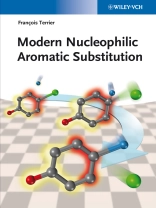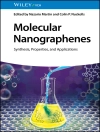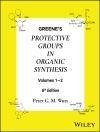This book provides a comprehensive overview of nucleophilic aromatic substitutions, focusing on the mechanistic and synthetic features that govern these reactions.
The first chapter presents a detailed mechanistic analysis of the factors determining the feasibility of SNAr substitutions, providing decisive information to predict regioselectivity of many reactions and to define the conditions for concerted SNAr processes. Reflecting the key role played by these species as intermediates in most SNAr reactions, chapter 2 then discusses the chemistry of anionic sigma-complexes. Chapter 3 describes the concept of superelectrophilicity in SNAr substitutions, as it has recently emerged from the reactivity of strongly electron-deficient aromatic and heteroaromatic structures. The numerous synthetic applications are considered in depth in the chapters 4 and 5 that follow on intermolecular and intramolecular nucleophilic aromatic substitutions. Then, chapter 6 focuses on substitutions proceeding formally through displacement of a hydride ion, a hot topic in the field. The final chapter brings together concise yet comprehensive discussions surrounding SNAr photosubstitutions, radical substitutions, and ANRORC substitutions.
Authored by a highly respected chemist who has contributed greatly to the field over the past two decades, this is a valuable information source for all organic chemists working in academia or the pharmaceutical and agrochemical industries.
Tabela de Conteúdo
THE SNAr REACTIONS: MECHANISTIC ASPECTS
Introduction
Activation of the Aromatic System: Driving Force for SNAr Reactions
Leaving Group, Nucleophile, Solvent, and Medium Effects
Effects of Specific Structural Variations in the Activated Ring
Spectral Evidence for the Intermediacy of sigma-Complexes in SNAr Reactions
Base Catalysis in SNAr Reactions
Regioselectivity in SNAr Reactions
Asymmetric SNAr Substitutions
Concerted SNAr Substitutions
Conclusion
STRUCTURE AND REACTIVITY OF ANIONIC SIGMA-COMPLEXES
Introduction
Structural Features of sigma-Complexes
Thermodynamics and Kinetics of sigma-Complex Formation
THE SUPERELECTROPHILIC DIMENSION IN SNAr AND RELATED SIGMA-COMPLEXATION PROCESSES
Introduction
The Classical Domain of SNAr and Anionic sigma-Complexation Reactivity
Reaching the Superelectrophilic Dimension
The Synthetic Potential of sigma-Complexation and SNAr Reactivity in the Superelectrophilic Dimension
Origin of the Superelectrophilicity of Neutral 10pi Heteroaromatics
SYNTHETIC ASPECTS OF INTERMOLECULAR SNAr REACTIONS
Introduction
Intermolecular Displacements of a Nitro Group
Intermolecular Displacements of Halogen and Other Leaving Groups
Conclusion
INTRAMOLECULAR SNAr REACTIONS
Introduction
SNAr Cyclizations
Smiles Rearrangements
Conclusion
NUCLEOPHILIC AROMATIC SUBSTITUTIONS OF HYDROGEN
Introduction
Reactions Involving Oxidation of sigma-Complex-Type Intermediates
Vicarious Nucleophilic Aromatic Substitutions of Hydrogen (VNS)
Deoxygenative SNAr H Substitutions
Cine and Tele Substitutions
Conclusion
OTHER SNAr SUBSTITUTION PATHWAYS
SN(ANRORC) Substitutions
Radical Nucleophilic Aromatic Substitutions
Nucleophilic Aromatic Photosubstitutions
Sobre o autor
Francois Terrier obtained his Ph D in 1968 from the University Pierre et Marie Curie in Paris. After postdoctoral research with Professor Bernasconi at the University of California, Santa Cruz, he was appointed Professor at the University of Rouen. In 1991 he moved to the new University of Versailles, where he holds a Professorship of organic chemistry. As the Head of the Department of Chemistry he developed a research lab focusing on various topics dealing with reactivity and physical organic chemistry, namely nucleophilic aromatic substitutions and sigma-complexation processes, alfa-effect nucleophiles and proton transfers at carbon. He has published over 200 papers, as well as a number of book chapters and review articles.












